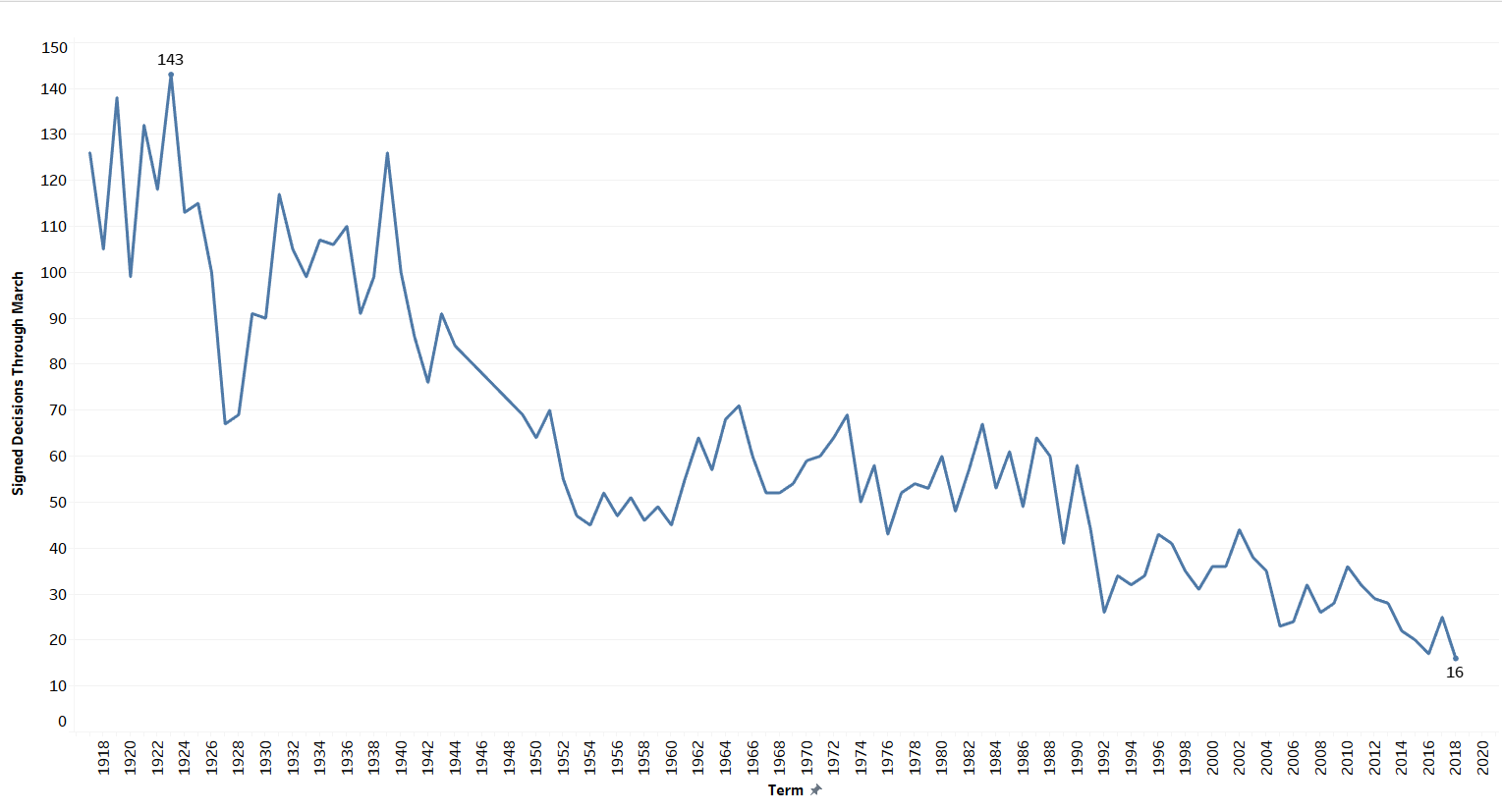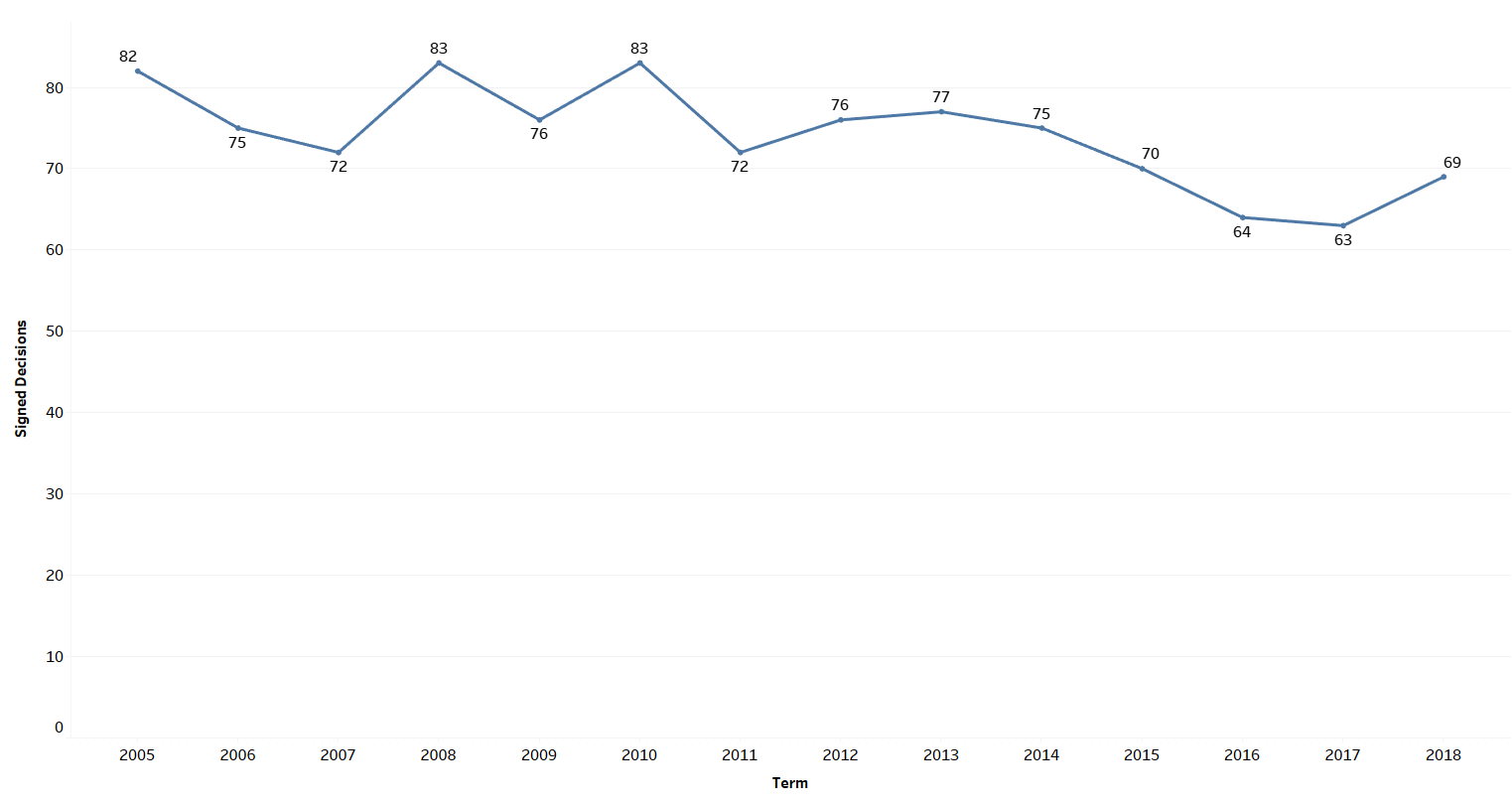Interim Stat Pack for October Term 2019

on Apr 3, 2020 at 12:44 pm

The Supreme Court has experienced a series of upheavals since October Term 2014 – and the current term is proving to be no exception. In February 2016, Justice Antonin Scalia passed away, leaving the court with eight members until Justice Neil Gorsuch came on board in April 2017. Then Justice Anthony Kennedy retired at the end of the 2017-2018 term. Justice Brett Kavanaugh took his place on the court in the second week of October Term 2018. Now with a slate of nine justices who could be on the court for several years to come, the court has stopped hearing oral arguments until further notice.
The last time the Supreme Court closed its doors to the public due to an epidemic was during the Spanish flu outbreak of 1918. Then though, the court postponed oral arguments by less than one month. This time will very likely be different. With no end in sight, the court is facing an entirely new situation. Moreover, with two justices in their 70s (Justices Samuel Alito and Clarence Thomas) and two in their 80s (Justices Ruth Bader Ginsburg and Stephen Breyer), extra precautions will likely be necessary before exposing the justices to anyone potentially carrying the coronavirus.
The last several terms have seen their share of anomalies. Because of its eight-justice composition, the court had several equally divided decisions in the 2015-2016 term. The justices seemed reluctant to grant many cases during the 2016-2017 term due to the question of who would fill Scalia’s vacant seat. This may have led the Roberts Court to decide fewer cases by signed decisions during each of the 2015-2017 terms than it had in any term prior (data for the two charts below provided by the Supreme Court Database).
Perhaps more surprising, through March of this term, the court has decided fewer cases by signed opinion than it has since at least before the Spanish flu closed the court’s doors in 1918.
The public is awaiting decisions in many important cases that have already been argued this term, including R.G. & G.R. Harris Funeral Homes Inc. v. Equal Employment Opportunity Commission and Bostock v. Clayton County, Georgia, both looking at Title VII’s protections against employment discrimination; Department of Homeland Security v. Regents of the University of California, involving the Trump administration’s decision to unwind the Deferred Action for Childhood Arrivals program, known as DACA; and New York State Rifle & Pistol Association Inc. v. City of New York, New York, which tests the constitutionality of New York City’s now-rescinded ban on transporting handguns. These cases and others already argued may be decided in the coming weeks. Others that have yet to be argued have a less clear time frame for resolution.
In decisions already rendered, all justices have written opinions except Chief Justice John Roberts. Ginsburg and Thomas have authored the most total opinions, with seven apiece. Ginsburg and Alito have written the most majority opinions, with three each, and Ginsburg has written more dissents than any other justice, with three. Thomas leads the concurrence count, authoring four.
In all three cases decided by 5-4 votes, the five more conservative justices were in the majority and the four more liberal justices were in dissent. It will be interesting to see whether this trend continues throughout the remainder of the term, as this is the first full term in which all nine of the current justices are expected to decide the full slate of cases together (minus three in which a justice is recused).
Roberts is the only justice who has agreed with the majority at the strictest level (“Fully Agree”) in all the cases that the court has decided this term. Roberts and Justice Brett Kavanaugh have the highest level of full agreement this term, at 95 percent. This pair also had one of the highest agreement levels last term, and so this will be another intriguing trend to follow.
Even with an odd and possibly curtailed term, there is much left unfinished on the Supreme Court’s plate. More decisions will almost certainly be released in already argued cases. The rest of the court’s business seems up in the air, and the justices, like the rest of the country, are likely waiting for things to calm down on the virus front before deciding how to tackle the remaining cases from this term.
Lastly, this Interim Stat Pack would not be complete without the tireless efforts of Kalvis Golde, Edith Roberts and Andrew Hamm. I would like to recognize their efforts in helping to put this together.
- Complete Interim Stat Pack
- Term Summary
- Term Index
- Opinions by Sitting
- Merits Cases by Vote Split
- Circuit Scorecards
- Opinions Authored by Each Justice
- Total Opinion Authorship
- Makeup of the Merits Docket
- Frequency in the Majority
- Justice Agreement
- Oral Argument – Advocates
- Pace of Grants
- Pace of Opinions
This post has been corrected to reflect that the chief justice is the only justice who has been in full agreement with the majority in every case this term, not the only justice who has been in the majority in every case.



